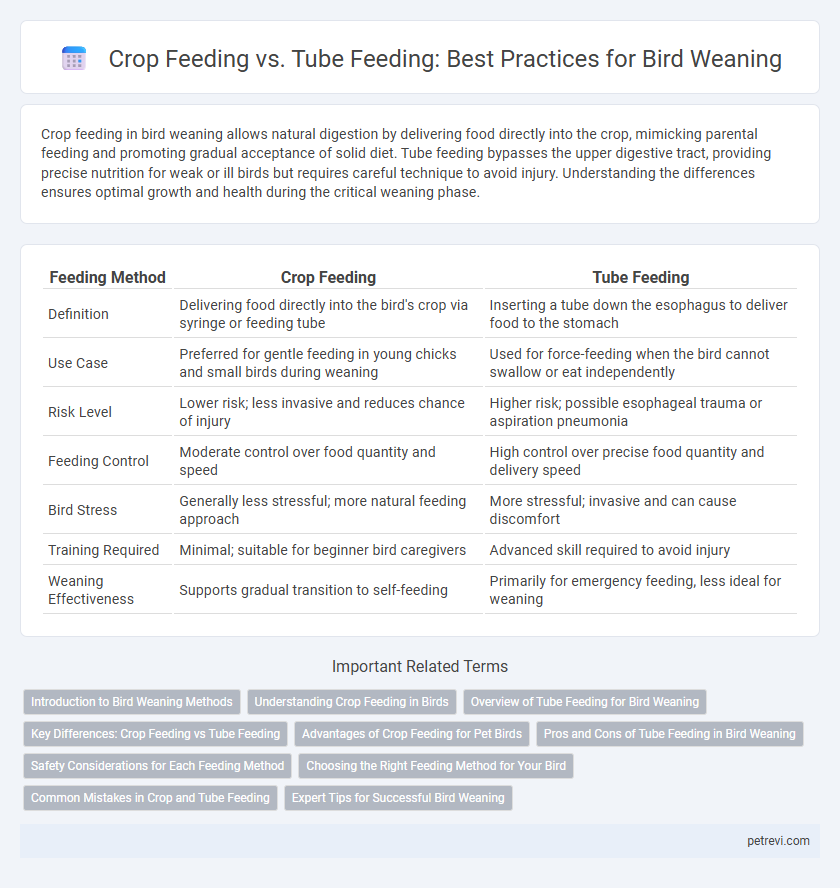Crop feeding in bird weaning allows natural digestion by delivering food directly into the crop, mimicking parental feeding and promoting gradual acceptance of solid diet. Tube feeding bypasses the upper digestive tract, providing precise nutrition for weak or ill birds but requires careful technique to avoid injury. Understanding the differences ensures optimal growth and health during the critical weaning phase.
Table of Comparison
| Feeding Method | Crop Feeding | Tube Feeding |
|---|---|---|
| Definition | Delivering food directly into the bird's crop via syringe or feeding tube | Inserting a tube down the esophagus to deliver food to the stomach |
| Use Case | Preferred for gentle feeding in young chicks and small birds during weaning | Used for force-feeding when the bird cannot swallow or eat independently |
| Risk Level | Lower risk; less invasive and reduces chance of injury | Higher risk; possible esophageal trauma or aspiration pneumonia |
| Feeding Control | Moderate control over food quantity and speed | High control over precise food quantity and delivery speed |
| Bird Stress | Generally less stressful; more natural feeding approach | More stressful; invasive and can cause discomfort |
| Training Required | Minimal; suitable for beginner bird caregivers | Advanced skill required to avoid injury |
| Weaning Effectiveness | Supports gradual transition to self-feeding | Primarily for emergency feeding, less ideal for weaning |
Introduction to Bird Weaning Methods
Bird weaning methods primarily involve crop feeding and tube feeding techniques designed to transition chicks from dependent feeding to independent eating. Crop feeding simulates natural feeding by delivering pre-digested food directly into the crop, enhancing nutrient absorption and reducing stress for young birds. Tube feeding, a more controlled approach, ensures accurate nutrient delivery, helping regulate feeding volumes and monitor bird health during critical growth stages.
Understanding Crop Feeding in Birds
Crop feeding in birds involves the transfer of regurgitated, partially digested food from the parent's crop to the chick, providing essential nutrients and enzymes for early development. This natural method supports the gradual adaptation of the chick's digestive system by introducing pre-digested food, ensuring optimal nutrient absorption and growth. Understanding crop feeding highlights its advantage over tube feeding, which may bypass the bird's natural digestive processes and increase stress during weaning.
Overview of Tube Feeding for Bird Weaning
Tube feeding for bird weaning involves delivering a specialized diet directly into the bird's crop using a soft feeding tube, ensuring precise nutrient intake and minimizing stress during the transition from hand-feeding to independent eating. This method supports optimal growth and health by providing consistent hydration and balanced nutrition, crucial for species with delicate digestive systems. Proper tube feeding technique reduces the risk of aspiration pneumonia and crop infections, making it a preferred practice in avian rehabilitation and breeding programs.
Key Differences: Crop Feeding vs Tube Feeding
Crop feeding involves placing food directly into the bird's crop, allowing natural digestion and reducing stress during weaning, while tube feeding requires inserting a feeding tube into the esophagus for precise nutrient delivery. Crop feeding supports gradual transition to self-feeding by mimicking parental feeding behavior, whereas tube feeding ensures exact control over feeding volume and timing, critical for weak or ill chicks. The choice between crop feeding and tube feeding depends on bird species, health condition, and caregiver experience to optimize growth and survival rates.
Advantages of Crop Feeding for Pet Birds
Crop feeding for pet bird weaning offers natural nutrition delivery closely mimicking parental feeding, promoting better digestion and nutrient absorption. This method reduces stress by providing warmth and moisture appropriate for developing crops, enhancing growth and immune function. It also helps establish a consistent feeding schedule, fostering trust between the bird and caregiver.
Pros and Cons of Tube Feeding in Bird Weaning
Tube feeding in bird weaning provides precise nutritional control and ensures consistent intake, especially for weak or reluctant chicks, promoting faster growth and stronger development. However, it carries risks such as injury to the esophagus, aspiration pneumonia, and requires skilled handling to avoid stress or improper feeding. Compared to crop feeding, tube feeding demands more expertise and equipment, making it less accessible for novice bird breeders.
Safety Considerations for Each Feeding Method
Crop feeding for bird weaning requires careful monitoring to prevent crop impaction and bacterial infections, emphasizing the importance of sterilizing feeding equipment and using appropriate feeding solutions. Tube feeding offers precise nutrient delivery but carries risks such as esophageal injury and aspiration pneumonia if improperly administered, necessitating experienced handling and strict hygiene protocols. Both methods demand close observation of the bird's swallowing response and overall health to ensure safe and effective weaning progress.
Choosing the Right Feeding Method for Your Bird
Selecting the ideal feeding method for bird weaning hinges on species, age, and health status, with crop feeding offering natural digestion simulation for hatchlings and tube feeding providing precise nutrition delivery in critical cases. Crop feeding allows gradual adaptation to solid foods while minimizing stress, whereas tube feeding ensures adequate nutrient intake when birds are weak or unable to swallow. Evaluating each bird's unique needs and consulting avian specialists enables optimal growth and development during the weaning process.
Common Mistakes in Crop and Tube Feeding
Common mistakes in crop feeding include overfilling the crop, leading to regurgitation and aspiration pneumonia, and improper food temperature causing digestive issues. In tube feeding, incorrect tube placement can result in tracheal injury or aspiration, while using inappropriate food consistency risks blockage or malnutrition. Consistent monitoring and technique refinement are crucial to prevent complications during bird weaning.
Expert Tips for Successful Bird Weaning
Crop feeding offers a natural way to transition young birds by mimicking parental feeding, enhancing nutrient absorption and immune development during weaning. Tube feeding ensures precise delivery of formulated nutrition, crucial for hand-rearing species with weaker feeding reflexes or health challenges. Experts recommend monitoring weight gain, maintaining hygiene, and gradually introducing solid foods to optimize weaning success and bird health.
Crop feeding vs Tube feeding for Bird weaning Infographic

 petrevi.com
petrevi.com